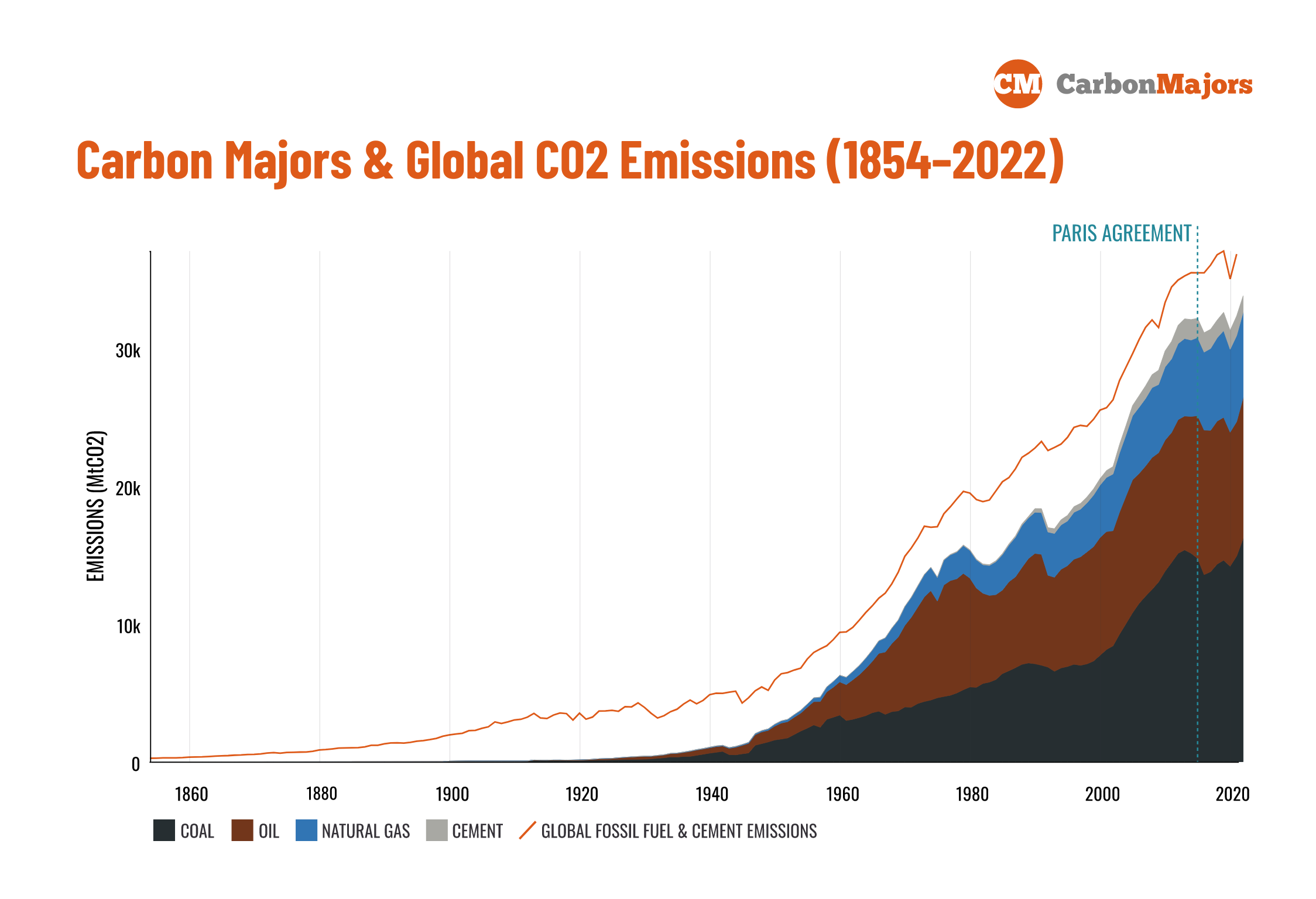A new report by InfluenceMap using the Carbon Majors database quantifies the contribution of the world’s largest oil, gas, coal, and cement producers to global carbon emissions, which are the primary driver of climate change. This report shows that the majority of global CO2 emissions produced since the Paris Agreement can be traced to a small group of high emitters who are failing to slow production. These 57 corporate and state entities can be linked to 80% of fossil fuel and cement CO2 emissions from 2016 through 2022. Nation-state producers account for 38% of emissions in the database since the Paris Agreement, while state-owned entities account for 37%, and investor-owned companies for 25%.
The Carbon Majors dataset contains emissions data from 1854 through 2022. New analysis of the whole dataset reveals that over 70% of global fossil fuel and cement CO2 emissions since the Industrial Revolution can be traced to 78 corporate and state producing entities. Over the same period, just 19 entities contributed 50% of these CO2 emissions.
Carbon Majors holds global significance as the first and only provider of this comprehensive view of corporate fossil fuel producers’ contributions to greenhouse gas emissions. The Carbon Majors dataset was first established in 2013 by Richard Heede of the Climate Accountability Institute and will now be hosted by InfluenceMap on the Carbon Majors website: carbonmajors.org.

Daan Van Acker, Program Manager at InfluenceMap, said:
“The Carbon Majors database is a key tool in attributing responsibility for climate change to the fossil fuel producers with the most significant role in driving global CO2 emissions. InfluenceMap’s new analysis shows that this group is not slowing down production, with most entities increasing production after the Paris Agreement. This research provides a crucial link in holding these energy giants to account on the consequences of their activities.”
The Carbon Majors dataset has proved crucial in holding fossil fuel producers to account for their climate-related impacts in academic, regulatory, and legal contexts. Examples include quantifying the contribution these entities have made to global surface temperature, sea level, and atmospheric CO2 rise; and establishing corporate accountability for climaterelated human rights violations in the Commission on Human Rights of the Philippines’ 2022 National Inquiry on Climate Change.
Caroll Muffett, President and CEO of the Center for International Environmental Law (CIEL) said:
*"Richard Heede's landmark Carbon Majors research transformed the landscape of climate accountability by using the fossil fuel industry's own reported production and operation figures to calculate and expose the true scale of its role in the climate crisis. By updating and extending that research—and making it more widely accessible and usable for researchers, decisionmakers, and litigators alike—InfluenceMap's new Carbon Majors database will transform that landscape yet again. The Carbon Majors database makes it dramatically easier to document, calculate, and visually demonstrate the growing chasm between the urgent demands of climate reality and the continued reckless and intentional growth of oil and gas production. Critically, it enables us to track changes in corporate behavior and production across discrete and clearly defined timescales that will be relevant to investors, investigators, and litigators alike. It is a vital and powerful new tool in the work toward climate action and climate accountability." *
Other key findings from this new analysis include:
Tzeporah Berman, International Program Director at Stand.earth and Chair at Fossil Fuel Non-Proliferation Treaty, said:
"The Carbon Majors research shows us exactly who is responsible for the lethal heat, extreme weather, and air pollution that is threatening lives and wreaking havoc on our oceans and forests. These companies have made billions of dollars in profits while denying the problem and delaying and obstructing climate policy. They are spending millions on advertising campaigns about being part of a sustainable solution, all the while continuing to invest in more fossil fuel extraction. These findings emphasize that, more than ever, we need our governments to stand up to these companies, and we need new international cooperation through a Fossil Fuel Treaty to end the expansion of fossil fuels and ensure a truly just transition."
Click here for full report and graphics
For further media information or to arrange interviews, please contact:
InfluenceMap
E: media@influencemap.org
Carbon Majors selects the largest fossil fuel and cement producing entities that meet a ≥8MtC/yr threshold. The assessed entities are divided into three entity types: investor-owned companies, state-owned companies, and nation-state producers. Nation-state producers are used primarily in the coal sector and are included only when investor-owned or state-owned companies haven’t been established or played a minor role in the relevant country. For oil, gas, and coal producers, the earliest production records are found. The data is standardized to a common commodity (Oil & Natural Gas Liquids, Natural Gas, and Coal) and multiplied by emissions factors that estimate the carbon content of each fuel type. This results in the emissions from marketed products (Scope 3) that constitute about 90% of the database’s total. Direct scope 1 emissions from the production are then also estimated using additional emission factors. This results in the total annual CO2 equivalent emissions produced by each entity.
Cement production emissions differ, estimated as a proportion of gross emissions reported by major cement companies to the Cement Sustainability Initiative. This proportion represents process emissions from limestone calcination, excluding fuel and electricity inputs to prevent double counting of fossil fuel emissions already considered in Carbon Majors.
This research compares the emissions tracked by the Carbon Majors database to total global fossil fuel and cement CO2 emissions since the beginning of the Industrial Revolution in 1751. Data from the Carbon Dioxide Information Analysis Center (CDIAC), and more recently the Global Carbon Project, provides this total.
For a more detailed look at the methodology please refer to Rick Heede’s 2014 paper “Carbon Majors: Methods & Results Report” available here.